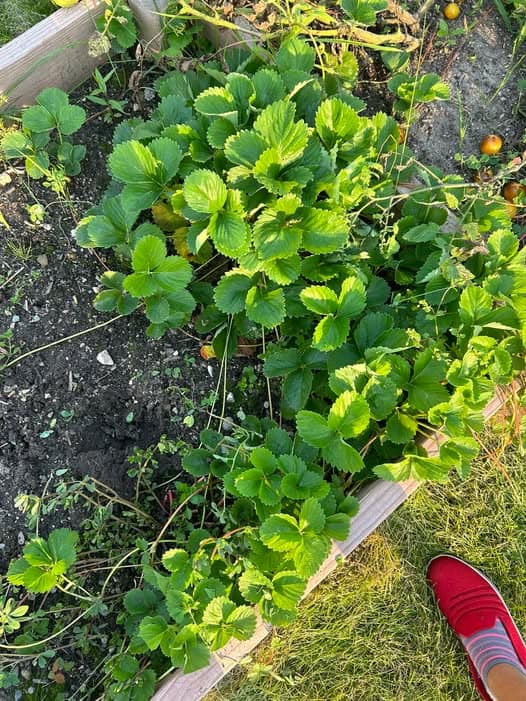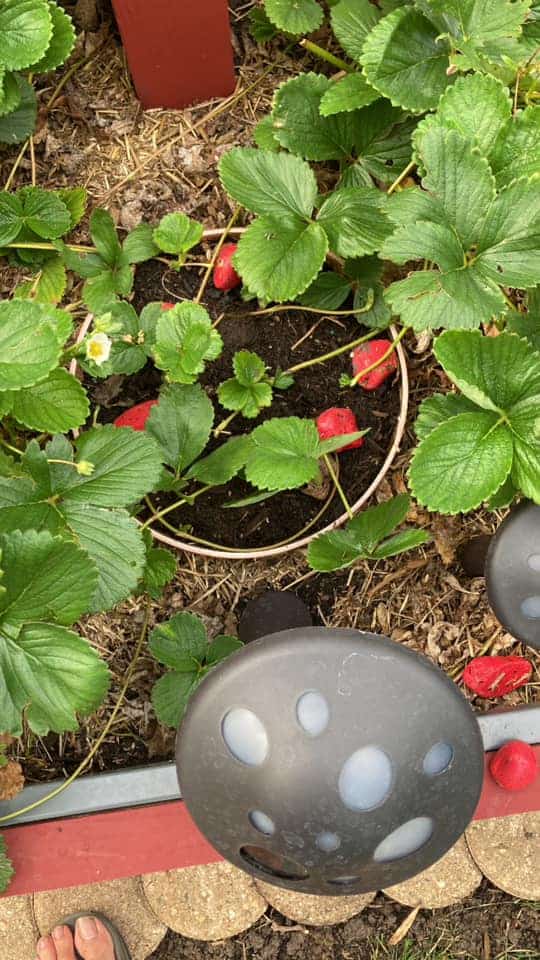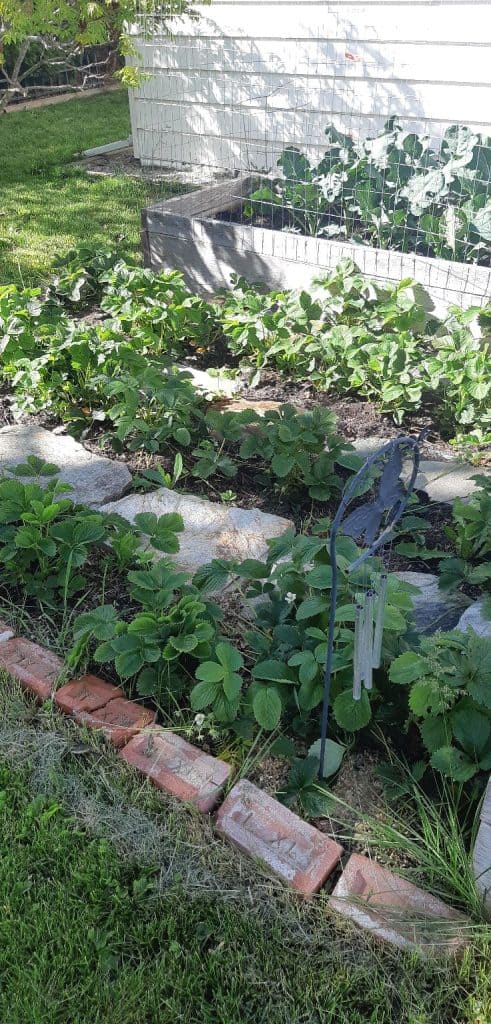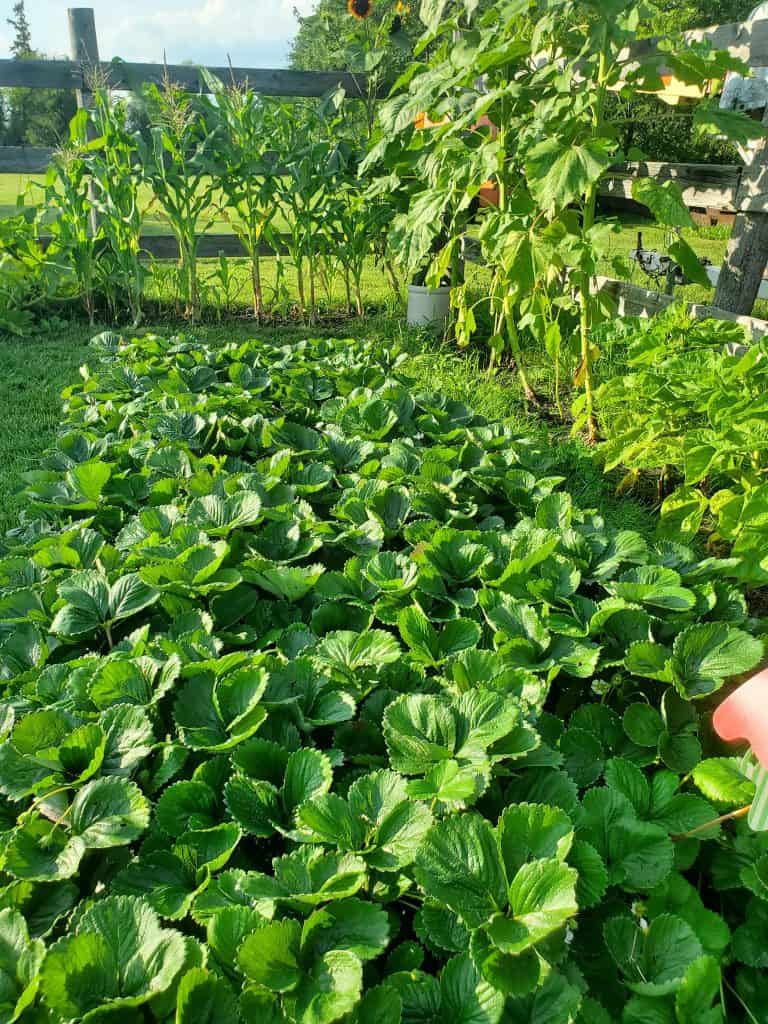Moving strawberries from one spot to another doesn’t have to be complicated. It’s one of those tasks that sounds trickier than it is – but a few small mistakes can absolutely wreck your harvest later.
Plant too deep, water the wrong way, or transplant at the wrong time… and suddenly you're wondering why nothing's fruiting.
In this article, I'll walk you through the whole deal – from digging up rooted runners to planting plugs, shifting mature plants from pots to beds, and even dealing with weird timing like flowering season or late snowmelt.
Need ideas on where to plant your strawberries? Check out these practical strawberry garden bed ideas!
Doesn’t matter if you’ve got a tidy raised bed or a half-wild patch out back – these methods are meant to work with what you’ve got.
Let’s get into it!
Types of Strawberry Plants to Transplant
Not all strawberry plants are in the same stage when it's time to move them. Knowing which kind you're dealing with helps you transplant the right way – without stressing the plant out or stalling its growth.
Plugs
These are young plants already rooted in small soil blocks – what you usually get from nurseries. They're tidy, uniform, and easy to work with. Just pop them out, plant them at soil level, and water well. Plugs are pretty forgiving.
Rooted Runners
These are the baby plants that shoot out from the mother plant. If they've already made roots in the soil, they’re good to go.
They might look small, but strawberries are tougher than they look. As long as they’ve rooted, they can move.
Dormant Plants
If your plants look dead in early spring (like in March in colder zones), they’re probably just dormant. As long as the crown is firm and not mushy, it’s still alive.
These can be transplanted, but they’ll need gentle care and a bit of patience to bounce back.
Established Plants in Containers
Got strawberries growing in hanging baskets or old pots? They can be moved to garden beds or bigger containers.
Just try to keep the root system together when shifting them – don’t shake it all loose unless you really have to.
Old, Unproductive Plants
Strawberries don’t last forever. If a plant’s been going for 7–10 years and barely fruits anymore, transplanting probably won’t help much. It’s better to replace it with a younger, more vigorous plant.
Preparing Before Transplanting
This part’s easy to overlook – but if you skip it, the plants struggle. Good prep sets them up to root fast and actually thrive in their new spot.
Choose the Right Spot
Strawberries need full sun and loose, well-drained soil. Avoid low, soggy areas or compacted clay. They’ll rot or just sulk there. Containers are fine too – just make sure they’re deep enough and drain well.
Fix the Soil
If the soil is sandy or too dense, mix in compost. For nutrients, bone meal or fish meal works great – slow-release, and organic.
But if you bought plugs, check if the nursery already added fertilizer. Don’t double up. Too much nitrogen = lots of leaves, no berries.
Plan the Layout
Give each plant space – about 12–18 inches apart. Crowding them leads to weak roots and more disease problems.
Also, if you're moving runners or thinning a patch, decide now where the extras will go – don’t wing it mid-process.
How to Transplant Plugs
Transplanting plugs is usually the easiest method. They’re already rooted and just need a good home in the soil.
Dig the Right Hole
Make your hole a bit wider and deeper than the plug. It shouldn’t be a tight fit – loose soil around the plug helps roots spread faster. Don’t just jab a stick in the ground and jam the plant in. Take your time here. It's worth it.
Set the Crown at the Right Level
The crown (that thick part where the leaves meet the roots) should sit right at the soil line. Burying it too deep can cause rot. Planting it too shallow means roots might dry out.
Aim for just right – level with the surrounding soil.
Backfill Gently
Loosely fill the hole with soil around the plug. Don’t press it down too hard. A little firmness is fine, but compacted soil chokes out air and roots need air. Just nudge it in gently.
Water Right Away
This part matters more than people think. Water the plug in right after planting. Not later. Right away. It settles the soil and helps eliminate air pockets that can dry out roots.
Make sure the water soaks in and doesn’t pool – if it does, your drainage is off.
And if you’ve got a lot of plugs to transplant? Do them one at a time. Seriously. Plant one, water it, then move on to the next. It’s slower, but plants bounce back faster this way.
How to Transplant Rooted Runners
These little offshoots are nature’s way of giving you more strawberry plants for free. Once they’ve put down roots, they’re ready to move – but you’ve got to handle them a bit differently than plugs.
Lift Carefully, But Don’t Stress Too Much
Strawberries are surprisingly tough. You don’t have to be super delicate with the roots but do try to keep a chunk of soil attached if you can. It makes the transition smoother.
If It’s Just a Root Nub, That’s Okay
Sometimes runners haven’t fully rooted yet. They’ve got a little nub, maybe some tiny root hairs. You can still transplant them. Just water them often and remove any flowers or new runners until they’re well established.
Garden Beds vs. Containers
You can move runners directly into garden beds or start them in containers if you’re not sure where they’ll go yet. But if they’re already rooted and you’ve got space, skip the container step. Less transplant shock that way.
Move Them Fast
Don’t let them sit out long. If you’re digging up a bunch, carry them in a bucket with soil still clinging to the roots. Then plant them immediately. The longer they’re out, the more stressed they get.
Moving Established Plants
Older strawberry plants can handle transplanting but they come with quirks. Whether they’re flowering, growing in containers, or just need a fresh start, timing and technique really matter here.
If They’re Flowering, You’ve Got Two Options
You can pinch off the flowers and transplant right away. That stops the plant from putting energy into fruit and helps it focus on rooting.
Or – if you’re close to harvest – wait it out, then transplant after picking. You’ll lose less fruit that way.
Moving from Containers to Beds (or Bigger Pots)
Keep the root ball together as much as you can. Don’t shake off all the soil unless you absolutely have to. This minimizes shock.
And if you’re dealing with something like a hanging basket or a tire planter, take your time – roots often grow in tight spirals that need a little unwinding.
Raised Beds Work but They Need Protection in Cold Climates
If you're in the north and switching from in-ground to raised beds, just know they lose heat faster. You might need straw mulch, row covers, or even a cold frame to help plants survive winter.
Transplanting Dormant Plants from Cold Ground to Greenhouse
This works but it’s a bit stressful for the plant. If your soil has just thawed and you're moving dormant crowns into a warm greenhouse, keep them shaded at first and ease into the heat.
Don’t expect instant growth, but they’ll usually adapt just fine.
After Transplanting Care
You got them in the ground. Great. Now comes the part that actually determines whether they live or stall out.
Water Deeply, Not Just at the Surface
Give each plant a good soak – enough that water reaches the lower roots. If water sits around the base without soaking in, your soil’s compacted or the drainage needs help. Fix it before it becomes a rot problem.
Add a Little Kelp, If You Want a Boost
Liquid kelp (diluted in water) isn’t magic but it kind of feels like it. It helps roots settle in faster and gives a nice trace mineral boost. Just don’t overdo it. A little goes a long way.
Skip the Extra Fertilizer If You Used Pre-Fed Plugs
Too much nitrogen = lots of leaves, not much fruit. If your plugs came pre-fertilized, let them settle in before adding more. If not, a handful of bone or fish meal at planting is plenty.
Use Row Covers in Cold or Windy Weather
Row covers aren’t just for frost – they protect from drying winds, sneaky late freezes, and even birds. If your plants are looking stressed, tossing a cover over them for a few days can make a big difference.
Managing Runners in Old Patches
Strawberries love to spread. It’s what they do. But if you let the runners take over, you’ll get a tangled mess of baby plants and hardly any berries. The key is knowing when to prune, when to move, and what to keep.
Too Many Runners = Less Fruit
The more energy the plant spends making new babies, the less it puts into flowering. In farms, runners get clipped often. In home gardens, people forget. It happens. Just know: if your patch is all leaves and no berries, runners are likely the reason.
If You Forgot to Prune, Don’t Panic – Transplant Instead
If things got crowded, no worries. Dig up the runners with decent roots and move them elsewhere. Garden beds, containers, random bare spots – they’ll take if you water them in well.
Thin Out in Late Spring
Spring’s the best time to clean house. The plants are growing, the roots are active, and you can actually see what’s what. Think of it like dividing flower bulbs but above ground. Separate out the healthiest baby plants and replant with space.
Keep the Best, Cut the Rest
Older, mature plants usually have the biggest crowns. Leave those in place. Remove their runners so they can focus on berries. Younger ones can be moved or cut if they’re weak. Runners that haven’t rooted yet? Toss them.
Sanitize Your Tools
Sounds nitpicky, but it matters. Use clean scissors or pruners when cutting runners. You don’t want to spread fungus or bacteria while trying to help the plant.
And hey, if you’re showing this to kids, call the runners “umbilical cords.” It sticks.
Strawberry Growing Tips
Not everyone has rows and rows of beds to rotate through. And not every plant is in peak condition. Here’s how to work with what you’ve got and still come out ahead.
1. No Room for Rotation? Let Part of the Bed Rest
You don’t need a fancy 3-bed system. Just skip planting in one section each year and work compost into it instead. It's not perfect, but it's good enough to refresh the soil and break pest cycles.
2. Old Plants? Time to Let Go
Even with good care, strawberry plants lose steam after about 7–10 years. You might get some leaves, but fruit production drops off hard. Replace them with new starts – it’s just part of the cycle.
3. Containers to Ground Is Totally Doable
If you're switching from pots to garden soil, treat them like plug transplants. Keep the roots intact as much as you can and water them in right away. Same goes in reverse – from ground to raised beds.
4. Overwintering in Cold Zones (Zone 3 and Below)
Don’t leave container strawberries out in a shed where it hits -30C. Instead, move them to a cool basement or pantry. They don’t need much light while dormant, just occasional moisture so the roots don’t dry out completely.
Now grab your trowel, get those berries in the ground, and watch them thrive.
Transplanting strawberries doesn’t have to be a big production.
Whether you’re working with plugs, runners, old container plants, or half-dormant survivors from early spring, the process is mostly the same: prep well, plant right, and follow up with good care.
The most important things? Keep the crown at soil level. Don’t suffocate the roots. Water deeply, not just a quick sprinkle. And go easy on the fertilizer unless you know your plants need it.
Pay attention to runners – they’re both a blessing and a problem. Great for propagating new plants, but if you leave them unchecked, they’ll choke out your patch and cut down fruit yield fast.
And remember, old plants don’t owe you anything. If they’re not producing, swap them out.
Adapt to what you’ve got – your zone, your garden size, your time. Strawberries are pretty forgiving once you get the basics down. Give them a good start, and they’ll usually take it from there.
Frequently Asked Questions (FAQs)
What’s the best time to transplant strawberries?
Early spring or late summer, depending on your climate. You want mild temperatures and moist soil – not blazing heat or frozen ground.
Can I transplant strawberries while they’re flowering?
Yes, but you should pinch off the flowers to help the plant focus on root growth. If possible, wait until after the harvest.
How do I know if a runner is ready to move?
If it has its own roots and a bit of soil clinging to them, it’s ready. Even small root nubs can work if you keep the soil moist.
Is it okay to transplant strawberries from pots into garden beds?
Totally fine. Just keep the roots intact, plant at the right depth, and water deeply right after moving.
Why are my plants growing lots of leaves but no fruit?
Too much nitrogen, usually from over-fertilizing. Also happens if the plant’s using energy to make runners instead of flowers.
Ready To Transform Your Garden?
Are you looking for the best way to layout your garden beds? Maybe you're feeling a bit stuck on how to make the most of your space?
We’ve got you covered! Check out our 101+ Garden Bed Layout Ideas for your next raised bed project. This guide is filled with creative and practical ideas that can help you design a garden that fits your style, whether you’re just starting out or have been gardening for years.
Get your copy today and get inspired to bring your gardening dreams to life.






